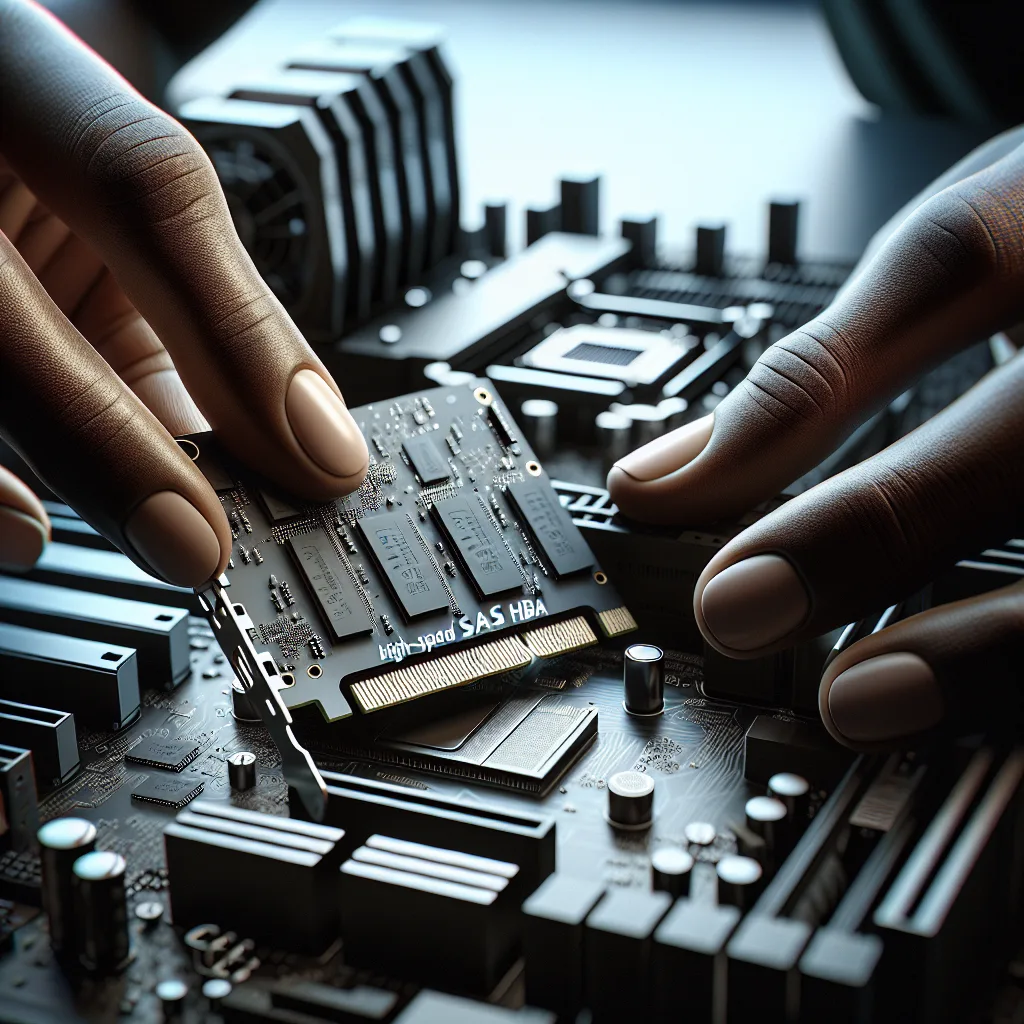Thinking of building a DIY NAS? Find out if a professional SAS HBA card will work with a standard consumer motherboard. We cover compatibility, drivers, and cables.
So you’re staring at a pile of parts for a new project. Maybe it’s a home server, a media-gobbling NAS (Network Attached Storage), or just a fun experiment for your home lab. You’ve got your consumer motherboard—something like a popular B550 model—and then you have this other part that feels a bit… different.
\n\nIt’s a SAS HBA, or Host Bus Adapter. A piece of enterprise-grade server hardware.
\n\nThe immediate question hits you: Can I plug this professional server card into my regular desktop motherboard? It feels like it should work, but mixing pro gear with consumer stuff can feel a little risky.
\n\nI’ve been there. Let’s talk about it.
\n\n### First Off, What Even Is a SAS HBA?
\n\nThink of it as a supercharged controller for your hard drives. Most of us are familiar with SATA ports—those little L-shaped connectors on our motherboards where we plug in our SSDs and hard drives. They’re great, but you usually only get a handful of them.
\n\nA SAS (Serial Attached SCSI) HBA is a card that slots into one of your motherboard’s PCIe slots (the same kind you use for a graphics card). Its main job is to let you connect a lot more drives than your motherboard can handle on its own. It’s common to see these cards with ports that can each handle four, eight, or even more drives. They’re built for servers that need massive amounts of storage.
\n\nThey’re loved by the home server community because you can often find powerful, used models from retired enterprise servers for a fantastic price.
\n\n### The Big Question: Will It Actually Work?
\n\nHere’s the short and sweet answer: Yes, almost always.
\n\nThat professional-looking SAS card and your consumer motherboard have a common language: PCIe (or PCI Express). It’s a standard. As long as you have a free PCIe slot that the card physically fits in (like an x8 or x16 slot), the motherboard will generally recognize that something has been plugged in.
\n\nFrom the motherboard’s perspective, it’s just another device that wants to talk to the rest of the system. It doesn’t really care if it’s a fancy graphics card or a storage controller from a data center.
\n\nSo, you can breathe a little easier. You didn’t buy an expensive paperweight.
\n\n### But… There Are a Few Things to Know
\n\nGetting it to work isn’t just about plugging it in and hoping for the best. There are a few practical details you need to get right.
\n\n1. The Operating System is Key
\n\nThis is the most important part. Your operating system (OS) needs the correct drivers to communicate with the HBA.
\n\n* For NAS/Server OSes (like TrueNAS, Unraid, Proxmox): You’re in luck. These operating systems are built for this kind of stuff. They often include drivers for popular LSI/Broadcom HBAs right out of the box. The OS boots up, sees the card, and knows exactly what to do. It’s usually a seamless experience.
* For Desktop Windows/Linux: It’s a bit more of a manual process. Windows won’t magically know what this server card is. You’ll likely need to go to the manufacturer’s website (like Broadcom for LSI cards) and download the appropriate driver for your version of Windows. It’s an extra step, but not a difficult one.
\n\n2. Don’t Forget the Cables!
\n\nThis is the #1 thing that trips people up. Your HBA won’t have the familiar SATA ports on it. Instead, it will have more dense connectors, like SFF-8643 or SFF-8087.
\n\nTo connect your regular SATA drives, you need what’s called a “breakout cable.” For example, you’d buy a cable that has an SFF-8643 connector on one end (for the HBA) and four standard SATA connectors on the other end (for your drives).
\n\nOrdering the card is easy. Forgetting to order the specific cables you need is a classic project-delaying mistake. (Ask me how I know.)
\n\n3. A Quick BIOS/UEFI Check
\n\nIn very rare cases, a motherboard’s BIOS/UEFI (the software that runs before your OS) can be a little picky. Sometimes, you might not see the card’s own boot menu appear. Generally, this isn’t a problem unless you intend to boot your operating system from a drive connected to the HBA. For most NAS builders, the OS is on a separate USB stick or SSD, so this is rarely an issue. A simple BIOS update on your motherboard often smooths out any weird compatibility quirks.
\n\n### The Bottom Line
\n\nSo, can you plug that server-grade SAS HBA into your consumer motherboard? Absolutely.
\n\nIt’s one of the best ways to get a massive amount of storage for a DIY NAS or home server without breaking the bank. It takes a tiny bit of homework, but the process is straightforward:
\n\n* Make sure the card physically fits in a free PCIe slot.
* Use a server-focused OS for the easiest setup.
* If using Windows, be ready to install a driver.
* And please, for the love of all things tech, order the right breakout cables.
\n\nDon’t be afraid to mix and match. Sometimes the most powerful and cost-effective solutions come from combining the worlds of consumer and enterprise tech. Now go get that build finished!
